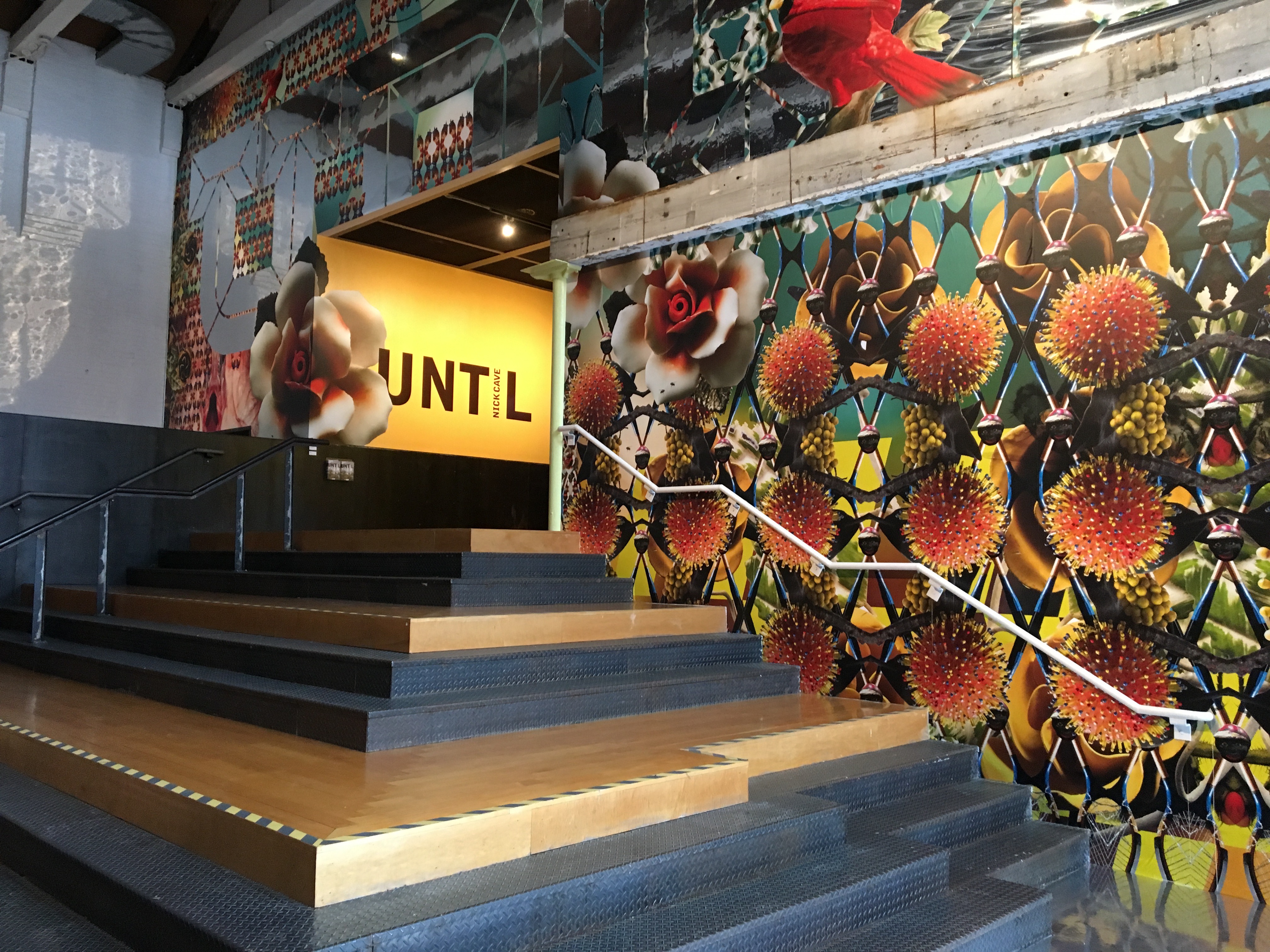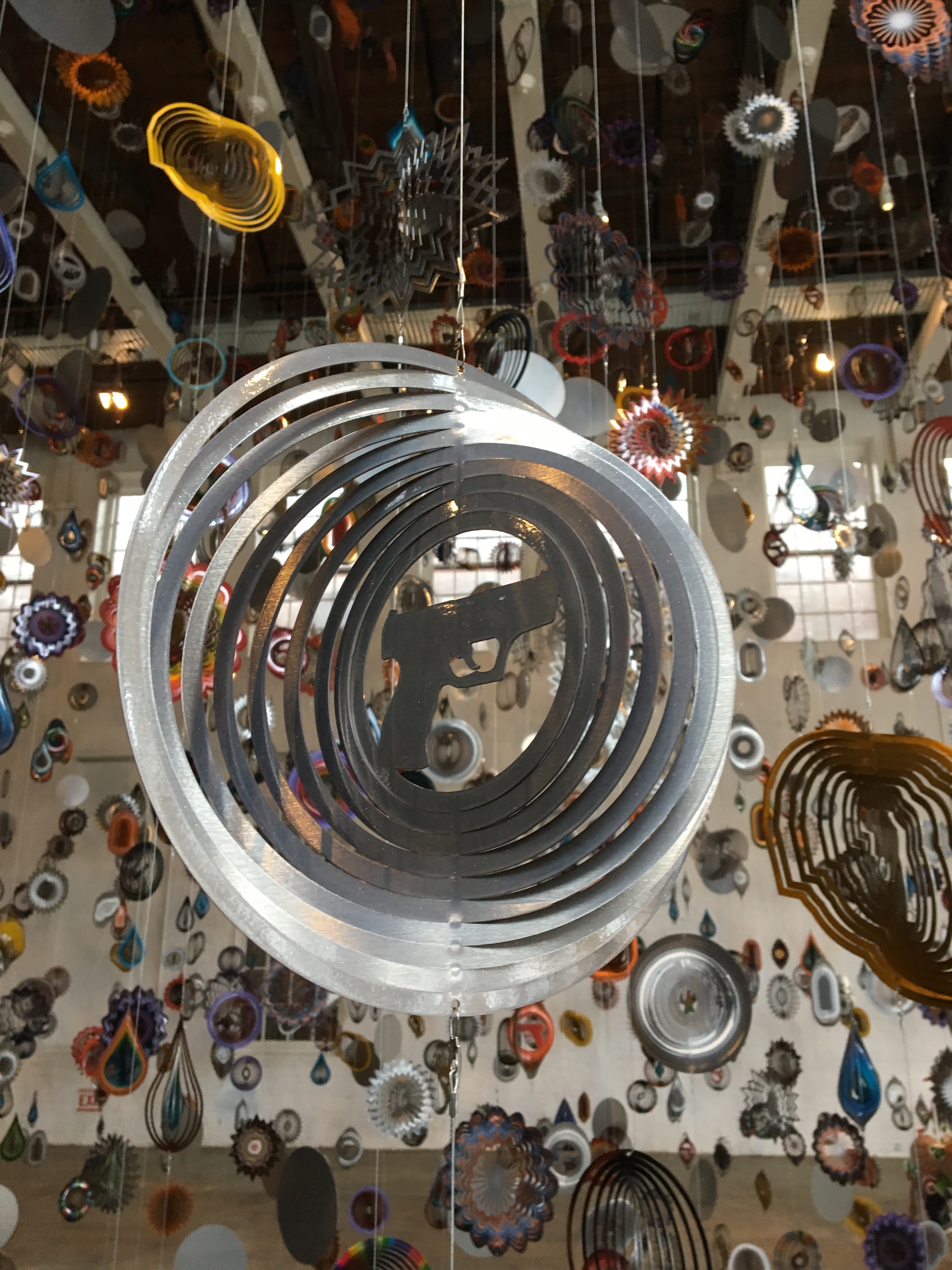
Nick Cave’s most recent installation, Until, is an immersive and subtle confrontation. When viewers actively engage with it, it becomes a conversation and perhaps even a collaboration between the artist and viewers, or more precisely, the artist and participants. Cave’s Until asks viewers to pay attention to the point at which they become participants in discussions about violence and race in America—right there in the gallery space itself.
Stretching out over more than an acre in MASS MoCA’s Building 5, this exhibition unfolds by first taking us down a path we’ve been down before—looking closely, seeing something, and then choosing to look away. Cave impresses a spectator (you’re really a spectator first, then a viewer, and finally a participant) with beautifully cut, colorful wind spinners you’ve seen a million times in yards across the country. Except when you look closely, you’re aware that you’re seeing colorful, glittering guns and bullets.
The path empties out into the middle of the gallery, and atop a large cluster of chandeliers sits a cloud you can literally climb into using flights of stairs similar to those used to board planes. When you get to the top you’re confronted a second time in a similar way, as familiar objects and images are juxtaposed with others more controversial, such as black lawn jockeys. You descend those stairs ready to talk, and in the spirit of Cave’s intent I twice took the opportunity to give this installation a test flight by having conversations with those around me.

The first time my family and I visited was on the last day of 2016, determined to talk about anything besides the antics of our then President-elect. The second time, I had the pleasure of co-facilitating a workshop for Berkshire region teachers with MASS MoCA’s Amanda Tobin and Laura Thompson.
On both occasions, simply asking questions about what is presented in this exhibition and how it can provoke a discussion proved to get the ball rolling. And on both occasions there were opportunities for others to relate personal experiences with these objects that evolved into lessons about race and being desensitized to violence. I learned about the families of those who participated in these conversations. I learned that generations are teaching children about a more inclusive and equitable America, despite what you may think about our current political leadership. These were inspiring conversations, and no one needed to start by saying, “Let’s have a conversation about race and violence.” It evolved.
The second half of the exhibition reminds us that no one is coming to save us except ourselves. Cave directs viewers into a separate video installation that suddenly features sound, spinning repeated imagery of a Cave Soundsuit head, and a huge lifeguard stand in the middle of the room that pierces the ceiling and emerges upstairs in the exhibition’s final stage.

Perhaps that final stage, after climbing another flight of stairs to the second floor, is about contemplation, focus, and planning. Confronted with a wall of mylar strips glistening with huge fans buzzing behind them, the word “FLOW” makes it’s way into focus. Is this the place where we have the opportunity to stop, think and make a commitment of some kind? Because in order to leave you must walk through the entire exhibition in reverse, and you can’t see the exhibition that second time through the same eyes you came in with. You notice different items submerged in the craft work, and purposeful installation of the show. And you wind up talking about that with those around you.
The way you get out is the same way you came in, but you may be a slightly different person by then.
Educators have a unique opportunity to use Until as a teaching tool, as a way to open up discussions that are difficult to initiate both in and out of classrooms. Because Cave has arranged this installation in a way that specifically provokes the question, What do you see?, it allows a conversation to organically emerge, much like Kerry James Marshall’s most recent retrospective, Mastry, at the Met Breuer. Through the act of talking about what you see, you can easily wind up talking about how these images are beautiful and charged, and what that says about where we are as a country.
Nick Cave’s Until is on view at MASS MoCA through August, 2017. Educators can schedule a visit for their classes and use the Season 8 Educators’ Guide featuring Nick Cave.
All photos courtesy of the author.



